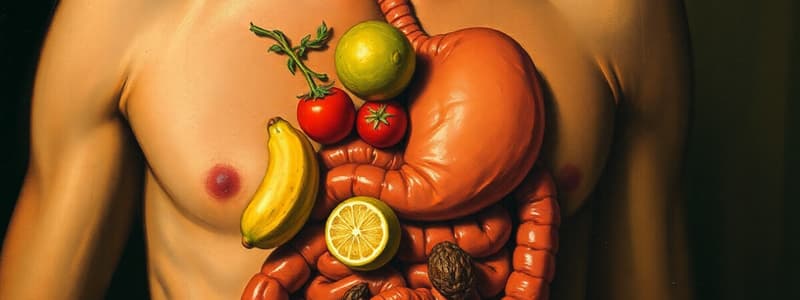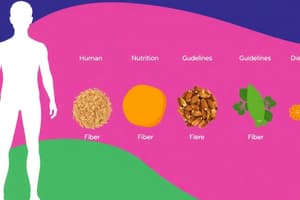Podcast
Questions and Answers
What is the primary function of digestion in the digestive system?
What is the primary function of digestion in the digestive system?
- The absorption of nutrients into the blood
- The ingestion of food and drink into the body
- The breakdown of large insoluble food molecules into smaller soluble ones (correct)
- The removal of undigested food from the body
Which organ is primarily associated with the absorption of nutrients into the blood?
Which organ is primarily associated with the absorption of nutrients into the blood?
- Large intestine
- Small intestine (correct)
- Pancreas
- Stomach
Which vitamin deficiency leads to scurvy?
Which vitamin deficiency leads to scurvy?
- Vitamin D
- Vitamin A
- Vitamin C (correct)
- Vitamin E
What process involves the removal of undigested food from the body?
What process involves the removal of undigested food from the body?
What is the role of carbohydrates in a balanced diet?
What is the role of carbohydrates in a balanced diet?
What is the main purpose of physical digestion?
What is the main purpose of physical digestion?
Which part of the tooth is responsible for sensation and supplying nutrients?
Which part of the tooth is responsible for sensation and supplying nutrients?
Which type of teeth is primarily used for crushing and grinding food?
Which type of teeth is primarily used for crushing and grinding food?
What distinguishes the enamel from other parts of the tooth?
What distinguishes the enamel from other parts of the tooth?
Which statement about wisdom teeth is accurate?
Which statement about wisdom teeth is accurate?
What is one primary function of teeth in the digestive process?
What is one primary function of teeth in the digestive process?
How does saliva facilitate the process of digestion?
How does saliva facilitate the process of digestion?
Which component in gastric juice is responsible for activating pepsinogen?
Which component in gastric juice is responsible for activating pepsinogen?
What role does mucus play in the digestive system?
What role does mucus play in the digestive system?
What is the primary method by which food is moved through the esophagus?
What is the primary method by which food is moved through the esophagus?
What substance in gastric juice is responsible for killing microbes in food?
What substance in gastric juice is responsible for killing microbes in food?
Which statement correctly describes pepsin?
Which statement correctly describes pepsin?
What does the physical digestion in the stomach primarily involve?
What does the physical digestion in the stomach primarily involve?
What is the primary function of amylase in pancreatic juice?
What is the primary function of amylase in pancreatic juice?
Which of the following components is NOT part of bile?
Which of the following components is NOT part of bile?
How does the structure of the ileum facilitate nutrient absorption?
How does the structure of the ileum facilitate nutrient absorption?
What type of nutrients are absorbed into blood capillaries from the villi?
What type of nutrients are absorbed into blood capillaries from the villi?
Which enzyme acts specifically on polypeptides in the digestive process?
Which enzyme acts specifically on polypeptides in the digestive process?
In terms of the absorption of fats, which structure plays a critical role?
In terms of the absorption of fats, which structure plays a critical role?
What is the effect of the ileum being very long on digestion?
What is the effect of the ileum being very long on digestion?
What is the main purpose of assimilation in the digestive process?
What is the main purpose of assimilation in the digestive process?
Which process describes the breakdown of food into smaller soluble molecules?
Which process describes the breakdown of food into smaller soluble molecules?
Which organ is NOT part of the alimentary canal?
Which organ is NOT part of the alimentary canal?
What is the role of water in a balanced diet?
What is the role of water in a balanced diet?
What deficiency primarily leads to the condition known as rickets?
What deficiency primarily leads to the condition known as rickets?
What is a primary characteristic of physical digestion?
What is a primary characteristic of physical digestion?
Which part of the tooth is primarily responsible for anchoring it to the jawbone?
Which part of the tooth is primarily responsible for anchoring it to the jawbone?
What distinguishes incisors from other types of teeth?
What distinguishes incisors from other types of teeth?
What is the primary role of bile in physical digestion?
What is the primary role of bile in physical digestion?
What is unique about wisdom teeth compared to other teeth?
What is unique about wisdom teeth compared to other teeth?
What is the primary role of bile in the digestive system?
What is the primary role of bile in the digestive system?
What is the consequence of proteases being secreted in an inactive form?
What is the consequence of proteases being secreted in an inactive form?
What is chyme in the context of digestion?
What is chyme in the context of digestion?
What is one key function of the duodenum?
What is one key function of the duodenum?
How does salivary amylase function in digestion?
How does salivary amylase function in digestion?
What type of nutrient is primarily digested in the small intestine?
What type of nutrient is primarily digested in the small intestine?
What component of bile helps to neutralize the acidic chyme coming from the stomach?
What component of bile helps to neutralize the acidic chyme coming from the stomach?
What is one of the primary roles of teeth in the digestive process?
What is one of the primary roles of teeth in the digestive process?
How does saliva assist with digestion?
How does saliva assist with digestion?
What is the function of hydrochloric acid in gastric juice?
What is the function of hydrochloric acid in gastric juice?
What role does mucus play in the stomach?
What role does mucus play in the stomach?
What mechanism moves food through the esophagus?
What mechanism moves food through the esophagus?
What happens to pepsinogen in the stomach?
What happens to pepsinogen in the stomach?
Which statement accurately describes the function of amylase in saliva?
Which statement accurately describes the function of amylase in saliva?
What is the overall purpose of physical digestion?
What is the overall purpose of physical digestion?
Flashcards
Balanced Diet
Balanced Diet
A diet that provides all the necessary nutrients in the correct proportions for good health.
Digestion
Digestion
The process of breaking down large, insoluble food molecules into smaller, soluble ones for absorption.
Absorption
Absorption
The process of taking in nutrients (small molecules) from the digestive system into the bloodstream.
Egestion
Egestion
Signup and view all the flashcards
Alimentary Canal
Alimentary Canal
Signup and view all the flashcards
Physical Digestion
Physical Digestion
Signup and view all the flashcards
Chemical Digestion
Chemical Digestion
Signup and view all the flashcards
Enamel (tooth)
Enamel (tooth)
Signup and view all the flashcards
Dentine (tooth)
Dentine (tooth)
Signup and view all the flashcards
Types of teeth
Types of teeth
Signup and view all the flashcards
Pancreatic Juice Components
Pancreatic Juice Components
Signup and view all the flashcards
Ileum Function
Ileum Function
Signup and view all the flashcards
Villi Adaptation
Villi Adaptation
Signup and view all the flashcards
Microvilli Function
Microvilli Function
Signup and view all the flashcards
Intestinal Lipase
Intestinal Lipase
Signup and view all the flashcards
Intestinal Peptidase
Intestinal Peptidase
Signup and view all the flashcards
Pancreatic lipase
Pancreatic lipase
Signup and view all the flashcards
Teeth Function
Teeth Function
Signup and view all the flashcards
Saliva Function
Saliva Function
Signup and view all the flashcards
Amylase Enzyme
Amylase Enzyme
Signup and view all the flashcards
Peristalsis
Peristalsis
Signup and view all the flashcards
Stomach Physical Digestion
Stomach Physical Digestion
Signup and view all the flashcards
Hydrochloric Acid in Stomach
Hydrochloric Acid in Stomach
Signup and view all the flashcards
Pepsin Enzyme
Pepsin Enzyme
Signup and view all the flashcards
Mucus in Stomach Lining
Mucus in Stomach Lining
Signup and view all the flashcards
Digestion
Digestion
Signup and view all the flashcards
Absorption
Absorption
Signup and view all the flashcards
Alimentary Canal
Alimentary Canal
Signup and view all the flashcards
Ingestion
Ingestion
Signup and view all the flashcards
Egestion
Egestion
Signup and view all the flashcards
Physical Digestion
Physical Digestion
Signup and view all the flashcards
Chemical Digestion
Chemical Digestion
Signup and view all the flashcards
Enamel (tooth)
Enamel (tooth)
Signup and view all the flashcards
Dentine (tooth)
Dentine (tooth)
Signup and view all the flashcards
Types of teeth
Types of teeth
Signup and view all the flashcards
Stomach Mucus
Stomach Mucus
Signup and view all the flashcards
Pepsin's Role
Pepsin's Role
Signup and view all the flashcards
Trypsin Action
Trypsin Action
Signup and view all the flashcards
Chyme Nature
Chyme Nature
Signup and view all the flashcards
Bile's role
Bile's role
Signup and view all the flashcards
Bile in Liver
Bile in Liver
Signup and view all the flashcards
Proteases' inactivity
Proteases' inactivity
Signup and view all the flashcards
Teeth Function
Teeth Function
Signup and view all the flashcards
Saliva Function
Saliva Function
Signup and view all the flashcards
Amylase Enzyme
Amylase Enzyme
Signup and view all the flashcards
Peristalsis
Peristalsis
Signup and view all the flashcards
Stomach Physical Digestion
Stomach Physical Digestion
Signup and view all the flashcards
Hydrochloric Acid in Stomach
Hydrochloric Acid in Stomach
Signup and view all the flashcards
Pepsin Enzyme
Pepsin Enzyme
Signup and view all the flashcards
Mucus in Stomach Lining
Mucus in Stomach Lining
Signup and view all the flashcards
Study Notes
Human Nutrition
- Human nutrition involves the processes of ingestion, digestion, absorption, assimilation, and egestion.
- A balanced diet provides all essential nutrients for proper bodily functions.
- Key dietary sources include carbohydrates, fats/oils, proteins, vitamins (e.g., C, D), minerals (e.g., calcium, iron), fiber, and water.
- Scurvy and rickets are diseases caused by deficiencies in vitamins C and D, respectively.
- The digestive system, including the alimentary canal (mouth, esophagus, stomach, small intestine, large intestine) and associated organs (salivary glands, pancreas, liver, gall bladder), is crucial for digestion.
- Ingestion is taking food into the body.
- Digestion breaks down large insoluble food molecules into smaller, soluble ones that can be absorbed.
- Absorption involves transferring small molecules into the blood.
- Assimilation is the use of absorbed nutrients by cells.
- Egestion is the removal of undigested food.
- Peristalsis is the movement of food through the esophagus.
- The stomach mechanically breaks down food and chemically digests proteins using pepsin and hydrochloric acid.
- Mucus protects the stomach lining from its own digestive juices.
- Chyme is the partially digested mixture leaving the stomach.
- The small intestine (duodenum and ileum) is the primary site for chemical digestion and absorption.
- Intestinal enzymes (e.g., lipase, peptidase, maltase) further breakdown food.
- Bile emulsifies fats.
- Pancreatic juice contains enzymes for all major food types.
- The ileum is adapted for absorption via villi and microvilli.
- Villi and microvilli increase the surface area for absorption, maximizing the rate of nutrient uptake.
- Blood capillaries absorb water-soluble nutrients, while lacteals absorb fats.
- The liver plays crucial roles in processing absorbed nutrients, detoxification, and producing bile.
- The hepatic portal vein connects the intestines to the liver.
- The hepatic vein carries nutrient-rich blood from the liver to the heart.
- Diseases like cholera can affect the digestive system, leading to diarrhea characterized by excessive loss of watery feces.
- Cholera bacteria cause this by producing toxins that trigger chloride ion secretion, leading to water loss and diarrhea.
Types of Teeth
- Incisors: Cutting and biting.
- Canines: Tearing.
- Premolars: Grinding.
- Molars: Crushing and grinding.
- Wisdom teeth: Grow later, used for grinding.
Digestive Enzymes
- Saliva contains amylase for carbohydrate digestion.
- Gastric juice contains pepsin for protein digestion and HCL for killing bacteria.
- Pancreatic juice contains amylases, lipases, proteases for all food types.
- Intestinal juices contain peptidases (amino acids), sucrases, lactases, and maltase for complete breakdown of all food types into simpler molecules.
Studying That Suits You
Use AI to generate personalized quizzes and flashcards to suit your learning preferences.




